Term 2 Unit 1 | History | 7th Social Science - Vijayanagar Kingdoms | 7th Social Science : History : Term 2 Unit 1 : Vijayanagar and Bahmani Kingdoms
Chapter: 7th Social Science : History : Term 2 Unit 1 : Vijayanagar and Bahmani Kingdoms
Vijayanagar Kingdoms
HISTORY
Unit -1
Vijayanagar and Bahmani Kingdoms
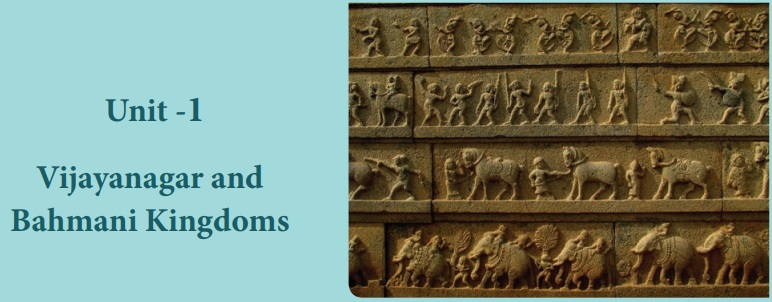
Learning Objectives
• To know the circumstances that led
to the rise and expansion of Vijayanagar and Bahmani kingdoms
• To familiarise ourselves with the
administration, military organisation and the economic life during the time of
their reign
• To know the contribution of
Vijayanagar and Bahmani rulers to literature art and architecture
Vijayanagar Kingdoms
Introduction
The political condition of India in the
fourteenth century provided great opportunities for the rise of new kingdoms in
the south. The repressive measures of the temperamental Muslim king Muhammad-bin-Tughlaq
led to the rise of many new independent states. In the south, Vijayanagar and Gulbarga
or Bahmani emerged as two great kingdoms. The Bahmani kingdom spread all over the
Maharashtra region and partly over Karnataka. Ruled by 18 monarchs, it lasted for
nearly 180 years. Early in the sixteenth century, it collapsed and split into five
sultanates – Bijapur, Ahmednagar, Golconda, Bidar and Berar. The state of Vijayanagar
continued to flourish for nearly 200 years. Ultimately Vijayanagar’s wealth and
prosperity induced the Muslim Deccan kingdoms to launch a combined war against it.
In 1565, the battle of Talikota, finally they could succeed in crushing Vijayanagar
Empire.
Foundation of Vijayanagar
Empire
Vijayanagara, the ‘city of victory’,
was established in southern Karnataka by two brothers named Harihara and Bukka.
According to one tradition, Vidyaranya, head of the Saivite Sringeri mutt, instructed
them to abandon their service to the Tughluqs and rescue the country from Muslim
authority. The new kingdom was called Vidyanagara for a time in honour of the spiritual
teacher Vidyaranya, before it came to be called Vijayanagara. Four dynasties, namely
Sangama (1336–1485), Saluva (1485–1505),
Tuluva (1505–1570) and Aravidu (1570–1646), ruled this kingdom.
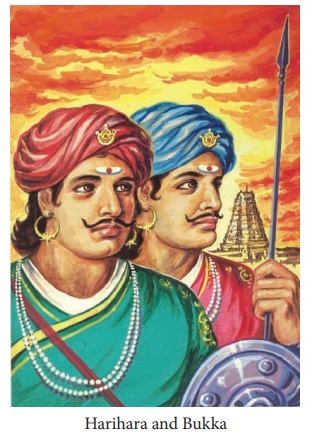
The fertile regions between the rivers
Krishna and Tungabhadra and the Krishna-Godavari delta were the zones of conflict
among the rulers of Vijayanagar, Bahmani and Odisha. The valour of the first two
brothers, Harihara and Bukka, of the Sangama dynasty protected the new kingdom from
the superior forces of the Bahmani sultanate, which had been established about a
decade after the foundation of Vijayanagara.
Bukka I’s son Kumara Kampana ended the sultanate in Madurai and succeeded
in establishing Nayak kingdom there. The conquest of the Madurai Sultanate by the
Vijayanagara empire is described in detail in the poem Madura Vijayam composed by
Kumara Kamapana’s wife Gangadevi.
End of Sangama Dynasty
When King Bukka died, he had left behind
a large territory to his son Harihara II to rule. Harihara II’s impressive achievement
was securing Belgaum and Goa from the Bahmani kingdom. Harihara’s son Devaraya I
defeated Gajapati kings of Odisha. His successor Devaraya II was the greatest ruler
of the Sangama dynasty. He began the practice of recruiting Muslim fighters to serve
him and to train him in the new methods of warfare.
Rise of Saluva Dynasty
After Devaraya II, the Vijayanagar Empire
went through a crisis. The able commander of the Vijayanagar army, Saluva Narasimha,
making use of the situation declared himself
the emperor, after murdering the last ruler of Sangama dynasty, Virupaksha Raya
II. But the Saluva dynasty founded by Saluva Narasimha came to an end with his death.
When Naras Nayaka, his able general, seized power, it ushered in the Tuluva dynasty.
Krishnadevaraya
Krishnadevaraya who reigned for 20 years
was the most illustrious rulers of the Tuluva dynasty. His first step after ascending
the throne was to bring under control the independent chieftains in the Tungabhadra
river basin. After succeeding in this effort, his next main target was Gulbarga.
The Bahmani sultan, Mahmud Shah, had been overthrown and kept in imprisonment by
his minister. Krishnadevaraya freed the sultan and restored him to the throne. Similarly,
he forced a war on Prataparudra, the Gajapati ruler of Odisha. Prataparudra negotiated
for peace and offered to marry off his daughter to him. Accepting the offer, Krishnadevaraya
returned the territory he had conquered from Prataparudra. Krishnadevaraya, with
the assistance of the Portuguese gunners, could easily defeat the Sultan of Golconda
and subsequently take over Raichur from the ruler of Bijapur.
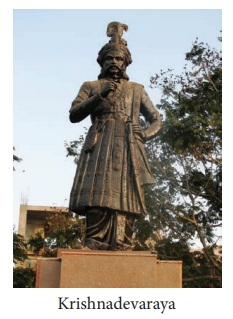
A Great Builder
Krishnadevaraya built huge irrigation
tanks and reservoirs for harvesting rainwater. He built the famous temples of Krishnaswamy,
Hazara Ramaswamy and Vithalaswamy in the capital city of Hampi. He distributed the
wealth he gained in wars to all major temples of South India for the purpose of
constructing temple gateways (gopura), called ‘Rayagopuram,’ in his honour.
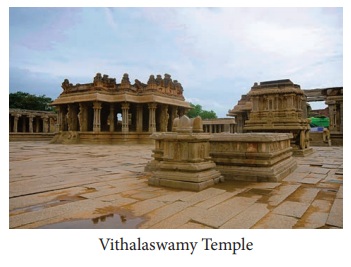
He recruited a large army and built many
strong forts. He imported large number of horses from Arabia and Iran, which came
in ships to Vijayanagar ports on the west coast. He had good friendly relationship
with the Portuguese and Arabian traders, which increased the Empire’s income through
customs.

Patron of Literature, Art
and Architecture
Krishnadevaraya patronised art and literature.
Eight eminent luminaries in literature known as astadiggajas adorned his
court. Alasani Peddana was the greatest of them all. Another notable figure was
Tenali Ramakrishna.
Battle of Talikota and
the Decline of Vijayanagar
Krishnadevaraya was succeeded by his
younger brother Achtyuda Deva Raya. After the uneventful reigns of Achtyuda Deva
Raya and his successor Venkata I, Sadasiva Raya, a minor, ascended the throne. His
regent Rama Raya, the able general of the kingdom, continued as a de facto ruler,
even after Sadashiva Raya attained the age for becoming the king. He relegated Sadasiva
Raya to a nominal king. In the meantime, the sultans of Deccan kingdoms succeeded
in forming a league to fight the Vijayanagar Empire. The combined forces of the
enemies met at Talikota in 1565. In the ensuing battle, known as Rakasa Tangadi
(Battle of Talikota), Vijayanagar was defeated. There was terrible human slaughter
and pillaging the capital city of Hampi. All the buildings, palaces and temples
were destroyed. The beautiful carvings and sculptures were desecrated. The glorious
Vijayanagar Empire had ceased to exist.
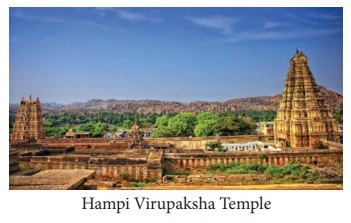
The site of the city of Vijayanagar on the bank of the river Tungabhadra
in eastern Karnataka is now called Hampi. Hampi is in ruins and the UNESCO has declared
it a heritage site.
Aravidu Dynasty
Rama Raya was killed on the battlefield
and his brother Tirumaladeva Raya managed to escape along with the king Sadasiva
Raya. Tirumaladeva Raya moved to Chandragiri carrying all the treasures and wealth
that could be salvaged. There he began the rule of Aravidu dynasty.
The Aravidu dynasty built a new capital
at Penukonda and kept the empire intact for a time. Internal dissensions and the
intrigues of the sultans of Bijapur and Golconda, however, led to the final collapse
of the empire about 1646.
Vijayanagar Administration
State
Kingship was hereditary, based on the
principle of primo geniture. But in some instances, the reigning rulers, in order to ensure peaceful succession,
nominated their successors. There were also instances of usurpation. Saluva Narasimha
usurped the throne and it led to the replacement of Sangama dynasty with Saluva
dynasty. The practice of appointing a regent to look after the administration, when
a minor succeeded the throne, was also prevalent.
Structure of Governance
The empire was divided into different
mandalams (provinces), nadus (districts), sthalas (taluks)
and finally into gramas (villages). Each province was administered
by a governor called Mandalesvara. The lowest unit of the administration was the
village. Each village had a grama sabha. Gauda, village headman, looked after the
affairs of the village.
The army consisted of the infantry, cavalry
and elephant corps. The army was modernised and Vijayanagar army began using firearms.
The combination of firearm and cavalry made them one of the most feared armies in
India.
Economic Condition
The Vijayanagar Empire was one of the
richest states then known to the world. Several foreign travellers, who visited
the empire during the fifteenth and the sixteenth centuries, left behind glowing
accounts of its splendour and wealth.The emperors issued a large number of gold
coins called Varahas.

Agriculture
It was the policy of its rulers to encourage
agriculture in different parts of the empire by following a wise irrigation policy.
Apart from the state, there were wealthy landholders and temples that invested in
irrigation to promote agriculture. Abdur Razzaq, the visiting Persian emissary to
Krishnadevaraya’s Court, records the huge tank built with the help of Portuguese
masons. Channels were constructed to supply water from the tank to different parts
of the city. The city was well stocked with a variety of agricultural goods.
Cottage Industries
Vijayanagar’s agricultural production
was supplemented by numerous cottage-scale industries. The most important of them
were textile, mining and metallurgy. Crafts and industries were regulated by guilds.
Abdur Razzaq, the makes a reference to separate guild for each group of tradesmen
and craftsmen.
Trade
During the Vijayanagar Empire, inland,
coastal and overseas trade flourished in goods such as silks from China, spices
from the Malabar region and precious stones from Burma (Myanmar). Vijayanagar traded
with Persia, South Africa, Portugal, Arabia, China, Southeast Asia and Sri Lanka.
Contribution to Literature
Under the patronage of Vijayanagar rulers,
religious as well as secular books were written in different languages such as Sanskrit,
Telugu, Kannada and Tamil. Krishnadeva Raya wrote Amuktamalyada, an epic
in Telugu and also a Sanskrit drama Jambavati Kalyanam. TenaliRamakrishna
authored Pandurangamahatyam. Scholars like Srinatha, Pothana, Jakkama and
Duggana translated Sanskrit and Prakrit works into Telugu.
Amuktamalyada is considered a masterpiece in Telugu literature. It
relates the story of the daughter of Periazhvar, Goda Devi (Andal), who used to
wear the garlands intended for Lord Ranganatha before they were offered to the deity,
and hence the name Amuktamalyada who wears and gives away garlands.
Contribution to Architecture
The temple building activity of the Vijayanagar
rulers produced a new style called the Vijayanagara style. Prominence of pillars
and piers, in large numbers, and the manner in which they were sculptured are hallmarks
of the Vijayanagara style. Horse was the most common animal to be depicted on the
pillars. The structures have a mandapam (open pavilion) with a raised platform,
generally meant for seating the deity on special occasions. These temples also have
a marriage hall with elaborately carved pillars.

Related Topics